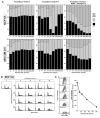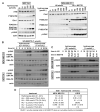Preclinical development of the novel Chk1 inhibitor SCH900776 in combination with DNA-damaging agents and antimetabolites
- PMID: 22203733
- PMCID: PMC3277678
- DOI: 10.1158/1535-7163.MCT-11-0406
Preclinical development of the novel Chk1 inhibitor SCH900776 in combination with DNA-damaging agents and antimetabolites
Abstract
Many anticancer agents damage DNA and arrest cell-cycle progression primarily in S or G(2) phase of the cell cycle. Previous studies with the topoisomerase I inhibitor SN38 have shown the efficacy of the Chk1 inhibitor UCN-01 to overcome this arrest and induce mitotic catastrophe. UCN-01 was limited in clinical trials by unfavorable pharmacokinetics. SCH900776 is a novel and more selective Chk1 inhibitor that potently inhibits Chk1 and abrogates cell-cycle arrest induced by SN38. Like UCN-01, abrogation of SN38-induced arrest enhances the rate of cell death but does not increase overall cell death. In contrast, SCH900776 reduced the growth-inhibitory concentration of hydroxyurea by 20- to 70-fold. A similar magnitude of sensitization was observed with cytarabine. A 5- to 10-fold sensitization occurred with gemcitabine, but no sensitization occurred with cisplatin, 5-fluorouracil, or 6-thioguanine. Sensitization occurred at hydroxyurea concentrations that marginally slowed DNA replication without apparent activation of Chk1, but this led to dependence on Chk1 that increased with time. For example, when added 18 hours after hydroxyurea, SCH900776 induced DNA double-strand breaks consistent with rapid collapse of replication forks. In addition, some cell lines were highly sensitive to SCH900776 alone, and these cells required lower concentrations of SCH900776 to sensitize them to hydroxyurea. We conclude that some tumors may be very sensitive to the combination of SCH900776 and hydroxyurea. Delayed administration of SCH900776 may be more effective than concurrent treatment. SCH900776 is currently in phase I clinical trials, and these results provide the rationale and schedule for future clinical trials.
Figures





Similar articles
-
The preclinical pharmacology and therapeutic activity of the novel CHK1 inhibitor SAR-020106.Mol Cancer Ther. 2010 Jan;9(1):89-100. doi: 10.1158/1535-7163.MCT-09-0938. Epub 2010 Jan 6. Mol Cancer Ther. 2010. PMID: 20053762
-
Targeting the replication checkpoint using SCH 900776, a potent and functionally selective CHK1 inhibitor identified via high content screening.Mol Cancer Ther. 2011 Apr;10(4):591-602. doi: 10.1158/1535-7163.MCT-10-0928. Epub 2011 Feb 14. Mol Cancer Ther. 2011. PMID: 21321066
-
The CHK1 inhibitor MU380 significantly increases the sensitivity of human docetaxel-resistant prostate cancer cells to gemcitabine through the induction of mitotic catastrophe.Mol Oncol. 2020 Oct;14(10):2487-2503. doi: 10.1002/1878-0261.12756. Epub 2020 Jul 16. Mol Oncol. 2020. PMID: 32579780 Free PMC article.
-
The cancer therapeutic potential of Chk1 inhibitors: how mechanistic studies impact on clinical trial design.Br J Clin Pharmacol. 2013 Sep;76(3):358-69. doi: 10.1111/bcp.12139. Br J Clin Pharmacol. 2013. PMID: 23593991 Free PMC article. Review.
-
Checkpoint kinase inhibitors: a patent review (2009 - 2010).Expert Opin Ther Pat. 2011 Aug;21(8):1191-210. doi: 10.1517/13543776.2011.586632. Epub 2011 May 20. Expert Opin Ther Pat. 2011. PMID: 21599421 Review.
Cited by
-
Combination therapy targeting the Chk1 and Wee1 kinases shows therapeutic efficacy in neuroblastoma.Cancer Res. 2013 Jan 15;73(2):776-84. doi: 10.1158/0008-5472.CAN-12-2669. Epub 2012 Nov 7. Cancer Res. 2013. PMID: 23135916 Free PMC article.
-
Comparison of the different mechanisms of cytotoxicity induced by checkpoint kinase I inhibitors when used as single agents or in combination with DNA damage.Oncogene. 2020 Feb;39(7):1389-1401. doi: 10.1038/s41388-019-1079-9. Epub 2019 Oct 28. Oncogene. 2020. PMID: 31659257 Free PMC article. Review.
-
Molecular pathways: targeting the dependence of mutant RAS cancers on the DNA damage response.Clin Cancer Res. 2015 Mar 15;21(6):1243-7. doi: 10.1158/1078-0432.CCR-14-0650. Epub 2014 Nov 25. Clin Cancer Res. 2015. PMID: 25424849 Free PMC article. Review.
-
Centromere fragmentation is a common mitotic defect of S and G2 checkpoint override.Cell Cycle. 2013 May 15;12(10):1588-97. doi: 10.4161/cc.24740. Epub 2013 Apr 24. Cell Cycle. 2013. PMID: 23624842 Free PMC article.
-
Depletion of ATR selectively sensitizes ATM-deficient human mammary epithelial cells to ionizing radiation and DNA-damaging agents.Cell Cycle. 2014;13(22):3541-50. doi: 10.4161/15384101.2014.960729. Cell Cycle. 2014. PMID: 25483091 Free PMC article.
References
-
- Sausville EA, Arbuck SG, Messmann R, Headlee D, Bauer KS, Lush RM, et al. Phase I trial of 72-hour continuous infusion UCN-01 in patients with refractory neoplasms. J Clin Oncol. 2001;19:2319–2333. - PubMed
-
- Bunch RT, Eastman A. Enhancement of cisplatin-induced cytotoxicity by 7-hydroxystaurosporine (UCN-01), a new G2-checkpoint inhibitor. Clin Cancer Res. 1996;2:791–797. - PubMed
-
- Kohn EA, Ruth ND, Brown MK, Livingstone M, Eastman A. Abrogation of the S phase DNA damage checkpoint results in S phase progression or premature mitosis depending on the concentration of UCN-01 and the kinetics of Cdc25C activation. J Biol Chem. 2002;277:26553–26564. - PubMed
-
- Wang Q, Fan S, Eastman A, Worland PJ, Sausville EA, O’Connor PM. UCN-01: a potent abrogator of G2 checkpoint function in cancer cells with disrupted p53. J Nat Cancer Inst. 1996;88:956–965. - PubMed
Publication types
MeSH terms
Substances
Grants and funding
LinkOut - more resources
Full Text Sources
Other Literature Sources
Miscellaneous

